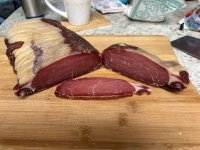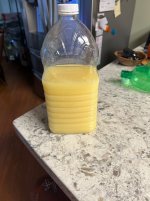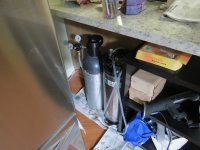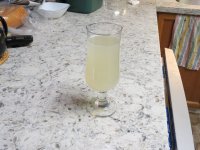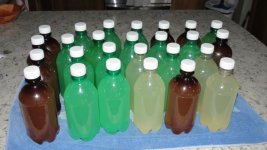We get tablets, Calcium 500 mg, Vitamin D3, Boron, Magnesium, Manganese, Zinc, Copper, Boron, in different comounds, all in one tablet.
They help me a lot in knee pain.
And do sit in mild sun for 30 minutes daily, helps in calcium absorption, without that the body cannot make Vitamin D, which is needed to absorb calcium.
Ice cream stabilizers include Glycerol Mono Steartae (foam stabilizer), and guar gum, cellulose gum and carob bean gum.
Take care, small kids can have different response to these.
Sherbet in India is a sugar syrup base with added natural , synthetic and mixes of these flavours.
They are diluted with water, sometimes milk is added, and served cold.
Many varieties exist, mango, rose, watermelon, orange, pineapple, strawberry etc.
There is also something called 'Thandai', look it up...
They help me a lot in knee pain.
And do sit in mild sun for 30 minutes daily, helps in calcium absorption, without that the body cannot make Vitamin D, which is needed to absorb calcium.
Ice cream stabilizers include Glycerol Mono Steartae (foam stabilizer), and guar gum, cellulose gum and carob bean gum.
Take care, small kids can have different response to these.
Sherbet in India is a sugar syrup base with added natural , synthetic and mixes of these flavours.
They are diluted with water, sometimes milk is added, and served cold.
Many varieties exist, mango, rose, watermelon, orange, pineapple, strawberry etc.
There is also something called 'Thandai', look it up...
Teeth Tony? I am an ex hockey player.
Let’s put it this way, my favourite meat is peanut butter.
Let’s put it this way, my favourite meat is peanut butter.
Ice cream is a stabilized foam.
Churning the mix as it went below freezing point was the old school method of making ice cream.
Commercially, it is done by machines, but the commercial ice creams tend to have additives that are used to strengthen the bubbles.
Edible gum is okay for kids in small quantities.
For home made ice cream, you need to churn the mixture, so if the equipment is lacking, do not bother.
Try mixing fresh fruit pulp in reduced sweetened milk, then chill before serving. Add pulp after cooking, Rabdi temperature below 35 degrees C.
For 'Rabdi', the classic recipe is to reduce 3 liters of full fat milk, with 350 grams of sugar, saffron and raisins / almonds / cashew to taste.
After the required condensed mil like consistency is reached, it is cooled, and consumed warm (delicious), or chilled, must finish in 3 days.
Mango and seasonal other fruit pulps are sometimes added.
The commercial ice cream is sold here by the liter, weight is between 275 and 475 grams per liter...milk has a density of about 1200 grams per liter...you are paying for air!
Stick to home made 'Kulfi', fruit pulp addition is a variation, the kids may or may not like it.
Use normal fruit, oranges etc. mot recommended, orange zest is okay.
Custard apple, avocado, strawberry, raspberry, bananas etc. are all possible.
I prefer to mix pulp and chopped fruit, better mouth feel and variation from smooth paste.
Have fun, make memories for your future.
Basically, frozen Rabdi is called Kulfi, and if the Rabdi is thickened more then cooled, you get a more solid product, one of them is called Barfi.
Churning the mix as it went below freezing point was the old school method of making ice cream.
Commercially, it is done by machines, but the commercial ice creams tend to have additives that are used to strengthen the bubbles.
Edible gum is okay for kids in small quantities.
For home made ice cream, you need to churn the mixture, so if the equipment is lacking, do not bother.
Try mixing fresh fruit pulp in reduced sweetened milk, then chill before serving. Add pulp after cooking, Rabdi temperature below 35 degrees C.
For 'Rabdi', the classic recipe is to reduce 3 liters of full fat milk, with 350 grams of sugar, saffron and raisins / almonds / cashew to taste.
After the required condensed mil like consistency is reached, it is cooled, and consumed warm (delicious), or chilled, must finish in 3 days.
Mango and seasonal other fruit pulps are sometimes added.
The commercial ice cream is sold here by the liter, weight is between 275 and 475 grams per liter...milk has a density of about 1200 grams per liter...you are paying for air!
Stick to home made 'Kulfi', fruit pulp addition is a variation, the kids may or may not like it.
Use normal fruit, oranges etc. mot recommended, orange zest is okay.
Custard apple, avocado, strawberry, raspberry, bananas etc. are all possible.
I prefer to mix pulp and chopped fruit, better mouth feel and variation from smooth paste.
Have fun, make memories for your future.
Basically, frozen Rabdi is called Kulfi, and if the Rabdi is thickened more then cooled, you get a more solid product, one of them is called Barfi.
Naresh-
I have one of these... a Cuisinart. The paddle "churns" the mixture as it freezes... takes about 20 to 25 minutes.
Then you're supposed to let it rest for a while, preferrably overnight.
The problem is that after a couple of days or so it become a solid block of ICED cream.
Adding additives is not the point.... the point is to make it as pure as possible... just cream, sugar (or Splenda), vanilla, fruits.... and make it last, in the freezer in a plastic container, for at least a couple of weeks.

I have one of these... a Cuisinart. The paddle "churns" the mixture as it freezes... takes about 20 to 25 minutes.
Then you're supposed to let it rest for a while, preferrably overnight.
The problem is that after a couple of days or so it become a solid block of ICED cream.
Adding additives is not the point.... the point is to make it as pure as possible... just cream, sugar (or Splenda), vanilla, fruits.... and make it last, in the freezer in a plastic container, for at least a couple of weeks.
Basically, the process needs to take the whole mix below freezing point, while not letting ice crystals grow.
It can be a process problem, a temperature during or after process problem, or a material problem, the foam is collapsing.
Try full fat milk, and a small batch with fresh fruit containing fiber, like bananas, can be tried separately.
Add thick cream if you feel it is the milk is not thick enough.
And ask your daughter, she is herself a chef, or let her ask a colleague, who is a pastry chef. They are trained for making sweet items, which are served mostly at room temperature, or below that.
The preparation for dinner service in a restaurant is sometimes in the afternoon, the items are stored until serving time...this may be something they do all the time.
I think mousse was having egg white as an ingredient, again the use is as a foam stabilizer.
As an aside, try 'gulab jamun' in warm sugar syrup...not at all good for diabetics!
It can be a process problem, a temperature during or after process problem, or a material problem, the foam is collapsing.
Try full fat milk, and a small batch with fresh fruit containing fiber, like bananas, can be tried separately.
Add thick cream if you feel it is the milk is not thick enough.
And ask your daughter, she is herself a chef, or let her ask a colleague, who is a pastry chef. They are trained for making sweet items, which are served mostly at room temperature, or below that.
The preparation for dinner service in a restaurant is sometimes in the afternoon, the items are stored until serving time...this may be something they do all the time.
I think mousse was having egg white as an ingredient, again the use is as a foam stabilizer.
As an aside, try 'gulab jamun' in warm sugar syrup...not at all good for diabetics!
Speaking of generators, the local Gov't here just installed a community battery about 50m from my house so, while we have few blackouts, we should be immune from here onwards. We were chosen for a trial as 52% of houses in the suburb have solar panels. It'll be interesting to see how it goes; all I know so far is that it looks like a shipping container with 'Community Battery' graphics.
Billshurv, you need stabilisers when your icecream container weighs more than about 30kg. 😉
As an aside, being neighbours and besties with NZ, we have the full range of Sistema ware in our supermarkets here.
Billshurv, you need stabilisers when your icecream container weighs more than about 30kg. 😉
As an aside, being neighbours and besties with NZ, we have the full range of Sistema ware in our supermarkets here.
We use the same Cuisinart countertop ice cream maker that Tony posted and love it. We actually have 2 of them after temporarily misplacing the stir paddle and top during our last move. Of course we found the lost parts shortly after replacing the unit. About once a summer I'll freeze all four bowls and make a variety for family bbq's. Ben and Jerry's put out a recipe book years ago and it's been nice to have. We've made a great variety from that book but the most requested, and my personal favorite, us butter peacn.
Sistema is buying raw material from the Far East, and shipping molded product to the UK....shipping component in the selling cost will be high.
There is only one maker of PP in Australia, may not be supplying proper grade fpr containers.
Tupperware India used to get their raw material from South Korea.
There must be local alternates in the UK, or Sistema's quality must be good.
There is only one maker of PP in Australia, may not be supplying proper grade fpr containers.
Tupperware India used to get their raw material from South Korea.
There must be local alternates in the UK, or Sistema's quality must be good.
You've clearly not looked at modern shipping economics.
For reasons I have not bothered to google the old companies in this field (tupperware, rubbermaid etc) have vanished from the shops. Sistema is certainly more resiliant than other containers. School lunches really test how beatings proof things are.
Kids are very happy to have ice cream again. good thing about home made is it's so rich they only need one scoop and don't complain they want more.
For reasons I have not bothered to google the old companies in this field (tupperware, rubbermaid etc) have vanished from the shops. Sistema is certainly more resiliant than other containers. School lunches really test how beatings proof things are.
Kids are very happy to have ice cream again. good thing about home made is it's so rich they only need one scoop and don't complain they want more.
I have been making plastic molded goods for 30-odd years.
I have been through this shipping cost rigmarole, this thread is not the right place to discuss that.
All I will say is that some companies get very high prices, then fade out.
Tupperware was shipping molds by air all over the world, the run in India would end, then off to Brazil, or whatever.
They had own selling channel, Tupperware parties and so on, they had only a few exclusive shops, and were charging about 10x what the local people were charging.
I read somewhere that they have filed for bankruptcy.
The actual manufacturer gets $3 to 4 per kilo of product at the factory gate, so check what you paid...the rest is shipping and profit.
The solid ice cream will be heavy, good, and you will add a lot less sugar than the commercial ones.
Check the sugar content in your soft drinks, many years back Pepsi Cola was 40% sugar in India, a 2 liter bottle had 600 grams, the US FDA says 15 grams is enough per adult.
So diabetes and obesity are guaranteed by drinking cola...stick to water.
I am thinking aloud, how would agar work in ice cream?
It is used in Vietnam, and in India, as a gelling agent in sweets, but as a foam reinforcer in ice cream?
No ties, as usual.
I have been through this shipping cost rigmarole, this thread is not the right place to discuss that.
All I will say is that some companies get very high prices, then fade out.
Tupperware was shipping molds by air all over the world, the run in India would end, then off to Brazil, or whatever.
They had own selling channel, Tupperware parties and so on, they had only a few exclusive shops, and were charging about 10x what the local people were charging.
I read somewhere that they have filed for bankruptcy.
The actual manufacturer gets $3 to 4 per kilo of product at the factory gate, so check what you paid...the rest is shipping and profit.
The solid ice cream will be heavy, good, and you will add a lot less sugar than the commercial ones.
Check the sugar content in your soft drinks, many years back Pepsi Cola was 40% sugar in India, a 2 liter bottle had 600 grams, the US FDA says 15 grams is enough per adult.
So diabetes and obesity are guaranteed by drinking cola...stick to water.
I am thinking aloud, how would agar work in ice cream?
It is used in Vietnam, and in India, as a gelling agent in sweets, but as a foam reinforcer in ice cream?
No ties, as usual.
Have either of you ever put it in the freezer while operating?We use the same Cuisinart countertop ice cream maker that Tony posted and love it.
The reason I ask is that the faster it freezes, the smaller the crystals, so I was just wondering...
or has anyone managed to score some LN2 to make REALLY small crystals? I've tried it, it really is better.
If you're vegan, it works fine. If not, gelatin is better.I am thinking aloud, how would agar work in ice cream?
For the record, Captain Calhoun does. He makes ginger beer. Sugar free. He uses the Monk fruit and Erythritol.for the record I don't drink soda
The perfect shandy mix for those scorching hot days, or a soda that warms your cockles in the winter.
Attachments
- Home
- Member Areas
- The Lounge
- The food thread
